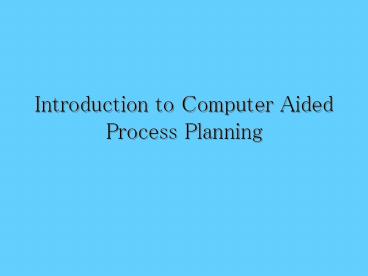Introduction%20to%20Computer%20Aided%20Process%20Planning - PowerPoint PPT Presentation
Title:
Introduction%20to%20Computer%20Aided%20Process%20Planning
Description:
Introduction to Computer Aided Process Planning Computer Integrated Manufacturing (CIM) Computer Aided Design (CAD) 2D 3D Concurrent Engineering Computer Aided ... – PowerPoint PPT presentation
Number of Views:935
Avg rating:3.0/5.0
Title: Introduction%20to%20Computer%20Aided%20Process%20Planning
1
Introduction to Computer Aided Process Planning
2
Computer Integrated Manufacturing (CIM)
- Computer Aided Design (CAD)
- 2D
- 3D
- Concurrent Engineering
- Computer Aided Process Planning (CAPP)
- Variant
- Generative
- Computer Aided Manufacturing (CAM)
- CNC
- Robotics
- Material Handling
- Just in Time (JIT)
- Group Technology
- Flexible Manufacturing Systems
3
What is process planning?
- Recipe/Algorithm/Step-by-step instructions
- Fast Food Chain
- Same taste everywhere from NY to New Delhi
- How do they do it?
- Customization in formal dinner restaurant
4
Manufacturing Environment
- Role of the master machinist in small batch
manufacturing - Manufacturing is more complex than cooking yet
the planning for it is similar - Job shop group machines which perform same
operation together - Routing of parts through the various departments
- Process plan defines the route
- Reduction in the necessary skill of operator can
be achieved by using a detailed process plan
5
Formal Definition
- Process planning can be defined as an act of
preparing processing documentation for the
manufacturing of a piece, part or an assembly - depending on the production environment can be
- Rough
- Detailed
- When process planning is done using a computer
Computer Aided Process Planning
6
Step-by-step operations in a sample part
7
- Manufacturing a part to meet design specs.
- Selection of initial block
- Sequence of operations
- Selection of machine, process
- Surface finish
- Quality
- Tolerance
- Hardness
- Life
- Cost
8
A Rough Process Plan
9
A Detailed Process Plan
10
Components of Process Planning
- Selection of machining operations
- Sequencing of machining operations
- Selection of cutting tools
- Determining the setup requirements
- Calculation of cutting parameters
- Tool path planning and generation of NC/CNC
programs - Design of Jigs/Fixtures
11
Process Planning in different environments
- In tool-room type manufacturing
- make part as per drawing is sufficient
- In metal-forming type operations
- The process planning requirements are embedded
directly into the die. - Process planning is fairly trivial
- Job-shop type manufacturing requires most
detailed process planning - Design of tools, jigs, fixtures and manufacturing
sequence are dictated directly by the process
plan.
12
Requirements for process planner
- Must be able to analyze and understand part
requirements - Have extensive knowledge of machine tools,
cutting tools and their capabilities - Understand the interactions between the part,
manufacturing, quality and cost
13
Traditional process planning
- Experienced based and performed manually
- Variability in planners judgment and experience
can lead to differences in the of what
constitutes best quality - Problem facing modern industry is the current
lack of skilled labor force to produce machined
parts as was done in the past - Hence Computer Integrated Manufacturing and
Computer Aided Process Planning
14
Advantages of CAPP
- Reduces the demand on the skilled planner
- Reduces the process planning time
- Reduces both process planning and manufacturing
cost - Creates consistent plans
- It produces accurate plans
- It increases productivity
15
Approaches to CAPP
- Variant
- Generative
- Automatic
16
Variant Process Planning
- based on the valid conjecture that similar parts
will have similar process plans - Preparatory stage
- GT-based part coding
- Families of similar parts are created
- Family matrix
- A process plan is to manufacture the entire
family is created
17
Variant Process Planning
- Production Stage
- Incoming part is coded
- Part family is identified
- Process plan is edited to account for the
different needs of the part - Salient points of variant process planning
- Easy to build, learn and use
- Experienced process planners are still required
to edit the process plan - Cannot be used in an entirely automated
manufacturing system without additional process
planning
18
Variant Process Planning
19
Generative Process Planning
- a system which automatically synthesizes a
process plan for a new component - Requires
- Part description
- Part to be produced must be clearly and precisely
defined in a computer compatible format
(OPITZ,AUTAP) - Manufacturing databases
- Logic of manufacturing must be identified and
captured - The captured logic must be incorporated in a
unified manufacturing database
20
Generative Process Planning
- Decision making logic and algorithms
- Decision trees
- Expert Systems
- AI based approaches
21
Automatic Process Planning
- generate a complete process plan directly from
a CAD drawing - Requires
- Automated CAD interface
- Take a general CAD model ( 3D for unambiguous
data) and develop an interface to develop a
manufacturing interface for this model Feature
Recognition of CAD - Design the parts with available manufacturing
features Feature based CAD - Dual useful features of both approaches
- Intelligent (computer based) process planner
22
Some process planning approaches
23
SUMMARY
- CAPP is a highly effective technology for
discrete manufacturers with a significant number
of products and process steps. - Rapid strides are being made to develop
generative planning capabilities and incorporate
CAPP into a computer-integrated manufacturing
architecture.
24
SUMMARY
- The first step is the implementation of GT and
coding. - Commercially-available software tools currently
exist to support both GT and CAPP.
25
SUMMARY
- As a result, many companies can achieve the
benefits of GT and CAPP with minimal cost and
risk. - Effective use of these tools can improve a
manufacturer's competitive advantage.
26
References
- Systems Approach To Computer Integrated Design
and Manufacturing - Author Nanua Singh
- Publisher John Wiley Sons
- Expert Process Planning For Manufacturing
- Author Tien-chien Chang
- Publisher Addison-Wesley Publishing Company

